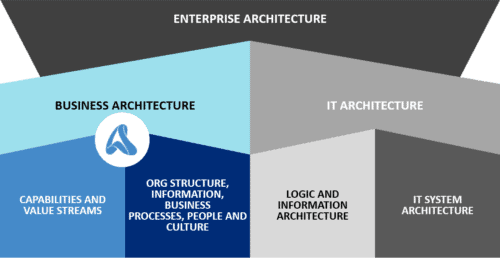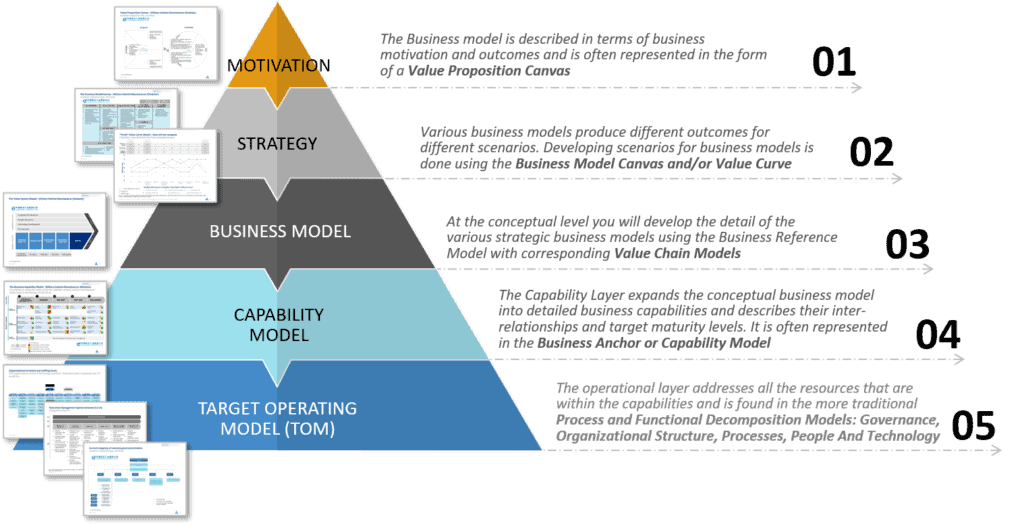Business Architecture Model and Principles

Business architecture is an essential part of an Enterprise Architecture related to a corporate business or an organization. Business architecture commonly answers the who, what, where, when, why, and how of day to day operations. BIZBOK is a framework of business architecture methods, best practices, and disciplines that answer the question, “How do I create successful business architecture?”

BIZBOK stands for Business Architecture Body of Knowledge, and it represents a framework of best practices and disciplines for business architects. A business architect is responsible for injecting reliable infrastructure into the corporate strategy execution and operating model.
At first glance, business architecture seems like a broad topic related to a diverse set of practices and techniques. Opinions vary as to what encompasses business architecture, and confusion stems from the fact that narrowly-focused business professionals have their distinct standpoints. Hence, there is no unified view of what business architecture covers.
In this article, we shall attempt to focus on business in business architecture and avoid any loosely related topics such as the use of technology non-essential to the core topics.
What is the business architecture model?
According to The Federation of Enterprise Architecture Domains (FEAPO), a Business Architecture Model represents holistic, multidimensional business views of capabilities, end‐to‐end value delivery, information, organizational structure, and the relationships among these business views and strategies, products, policies, initiatives, and stakeholders.
Business architecture is a simplified representation of all aspects related to a business. Being a streamlined version of reality, business architecture models help account for all the independent and interdependent parts of a business.
Still, the various independent and interdependent parts form complex interactions. Their components interact with one another in unexpected ways. It is the business architect who needs to identify how each piece works and interacts with other elements. However, it should be noted that a perfect business architecture model is impossible to design.
This article will aim to be as comprehensive as possible and is based on real-world experience gained through the involvement in numerous business projects.
Why do we need a business architecture model?
To understand the necessity for a business architecture model, let us define the purpose of any business.
The goal of any business is to deliver value to business stakeholders, internal and external. To achieve business goals, an organization must provide a satisfying product or service to its customers and clients and satisfy the needs of the owner(s), staff, and even the community, suppliers, and regulatory bodies. That necessitates understanding what drives each stakeholder group and providing an experience of superior quality.
The organization’s relationships with each external group largely dictate its success. All other efforts should be directed into delivering desired outcomes to those in your organization’s ecosystem.

Taking all this into account is an incomprehensibly complex process. Numerous interconnected components must work together towards achieving business goals. The list below mentions some of the more common business architecture components that must be accounted for, understood, optimized, and associated with a need to maximizing business efforts:
- The Business Motivation Model: offers a set of valuable concepts to consider, a standard vocabulary, and a flexible model to support development processes. Its main concepts are Influencers, Assessments, Ends, and Means, all of which are further broken down into more granular notions.
- Business Strategy: business strategy intent, business products and services, general business strategy.
- A business model: describes the rationale of how an organization creates, delivers, and captures value in economic, social, cultural, or other contexts.
- Business Capabilities: physical assets, IT resources, general business capabilities, workforce competency, organizational structure, organizational culture, incentives.
- Target Operating Model: enables the application of a corporate strategy or vision to a business or operation.
To truly comprehend and analyze the components, we need a high-level approach. The relationships among components can vary from simple to extremely complex, and tackling the components one by one is not a viable option. We need a business architecture model to associate all the components and analyze their interactions so that we can draw logical conclusions and provide actionable advice.
Author